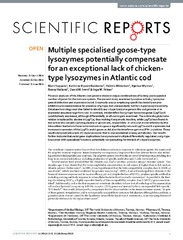| dc.contributor.author | Seppola, Marit | |
| dc.contributor.author | Bakkemo, Kathrine Ryvold | |
| dc.contributor.author | Mikkelsen, Helene V. | |
| dc.contributor.author | Myrnes, Bjørnar | |
| dc.contributor.author | Helland, Ronny | |
| dc.contributor.author | Irwin, David | |
| dc.contributor.author | Nilsen, Inge Waller | |
| dc.date.accessioned | 2016-08-29T08:23:32Z | |
| dc.date.available | 2016-08-29T08:23:32Z | |
| dc.date.issued | 2016-06-21 | |
| dc.description.abstract | Previous analyses of the Atlantic cod genome showed unique combinations of lacking and expanded number of genes for the immune system. The present study examined lysozyme activity, lysozyme gene distribution and expression in cod. Enzymatic assays employing specific bacterial lysozyme inhibitors provided evidence for presence of g-Type, but unexpectedly not for c-Type lysozyme activity. Database homology searches failed to identify any c-Type lysozyme gene in the cod genome or in expressed sequence tags from cod. In contrast, we identified four g-Type lysozyme genes (LygF1a-d) constitutively expressed, although differentially, in all cod organs examined. The active site glutamate residue is replaced by alanine in LygF1a, thus making it enzymatic inactive, while LygF1d was found in two active site variants carrying alanine or glutamate, respectively. In vitro and in vivo infection by the intracellular bacterium Francisella noatunensis gave a significantly reduced LygF1a and b expression but increased expression of the LygF1c and d genes as did also the interferon gamma (IFN3) cytokine. These results demonstrate a lack of c-Type lysozyme that is unprecedented among vertebrates. Our results further indicate that serial gene duplications have produced multiple differentially regulated cod g-Type lysozymes with specialised functions potentially compensating for the lack of c-Type lysozymes. | en_US |
| dc.description.sponsorship | This work was funded by the Research Council of Norway (Grant number 199672/E40). | en_US |
| dc.description | Publisher's version, source: <a href=http://doi.org/10.1038/srep28318>http://doi.org/10.1038/srep28318</a>. | en_US |
| dc.identifier.citation | Scientific Reports 6, 28318 (2016) | en_US |
| dc.identifier.cristinID | FRIDAID 1363281 | |
| dc.identifier.doi | 10.1038/srep28318 | |
| dc.identifier.issn | 2045-2322 | |
| dc.identifier.uri | https://hdl.handle.net/10037/9573 | |
| dc.identifier.urn | URN:NBN:no-uit_munin_9132 | |
| dc.language.iso | eng | en_US |
| dc.publisher | Nature Publishing Group | en_US |
| dc.relation.projectID | Norges forskningsråd: 199672 | |
| dc.relation.uri | file://homer.uit.no/ini031/My%20Documents/New%20science/SciRep/Published_srep28318_210616.pdf | |
| dc.rights.accessRights | openAccess | |
| dc.subject | VDP::Landbruks- og Fiskerifag: 900::Fiskerifag: 920::Andre fiskerifag: 929 | en_US |
| dc.subject | VDP::Matematikk og Naturvitenskap: 400::Zoologiske og botaniske fag: 480::Marinbiologi: 497 | en_US |
| dc.subject | VDP::Matematikk og Naturvitenskap: 400::Basale biofag: 470::Genetikk og genomikk: 474 | en_US |
| dc.title | Multiple specialised goose-type lysozymes potentially compensate for an exceptional lack of chickentype
lysozymes in Atlantic cod | en_US |
| dc.type | Journal article | en_US |
| dc.type | Tidsskriftartikkel | en_US |
| dc.type | Peer reviewed | en_US |


 English
English norsk
norsk